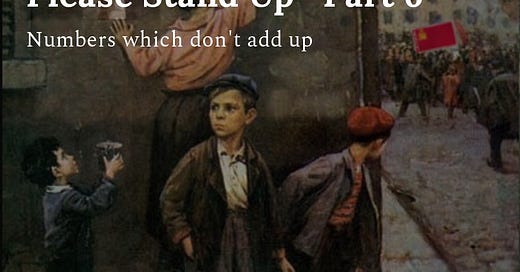September 1, 2023
Two academics from Yale (alma mater of Attorney Ramaswamy) , Jeffrey A. Sonnenfeld and Steven Tian, dug into Mr. Ramswamy’s back income tax records and discovered interesting details which do not support his purported narrative. Jeffrey Sonnenfeld is the Lester Crown Professor in Management Practice and Senior Associate Dean at Yale School of Management. Steven Tian is the director of research at the Yale Chief Executive Leadership Institute. The two have studied Mr. Ramaswamy’s business record and found it lacking:
His supposedly successful business track record, with supporters celebrating him as a “billionaire entrepreneur” with a triumphant record of value creation and who is not beholden to the elites. Even The Wall Street Journal’s editorial board has trumpeted Ramaswamy’s supposed business background repeatedly in glowing editorials. [See our companion article on his cozy relationship with the WSJ editorial page.] But the haze of fact-free hype surrounding Ramaswamy’s business exploits obfuscates some of the key questions about his true business background which have gone unanswered. We revealed his checkered business track record.
If the hype surrounding Ramaswamy is to be believed, he made billions by “conjuring drug companies from thin air” before branching out into other successful ventures.
In reality, few of Ramaswamy’s drugs have ever made it past testing, with his failures far outnumbering his successes. In one particularly illuminating example, Ramaswamy first rode to prominence and fortune in 2015 by hyping a supposed drug for Alzheimer’s named Axovant, which ultimately failed.
An obsequious Forbes profile from 2015 captures the initial hype surrounding Ramaswamy’s Axovant IPO. “Vivek Ramaswamy…rang the bell of the NYSE to launch the biggest initial public offering in the history of the American biotechnology industry. Ramaswamy’s Bermuda-based company, Axovant Sciences, had been formed only eight months earlier, but here it was raising $360 million to develop an Alzheimer’s drug that had been all but abandoned by GSK. On the first day of trading the stock almost doubled, giving Axovant a market capitalization of nearly $3 billion.
. . . , virtually all of Ramaswamy’s companies operate in the red, and none have ever turned a profit consistently. His flagship holding company, Roivant, has never once turned a profit since going public, losing $433 million in 2020, $698 million in 2021, and a whopping $1.12 billion in 2022, with Bloomberg predicting another $1.03 billion in losses in 2023.
[Together, these losses total $3.281 billion. Now is it clear why he left the industry to focus on politics?]
As we have shown previously, another one of Ramaswamy’s flagship ventures, Strive Asset Management, is stagnating with its largest ETF, the Strive US Energy ETF (DRLL), having less AUM today than it did when it was launched in August/September 2022. Its AUM is down nearly 25% from the start of this year alone, and Strive’s so-called activist campaigns are laughed off by CEOs who think it is a bad joke.
The two note that Ramaswamy’s first claimed business coup does not add up:
A huge part of Ramaswamy’s self-created origin story is how he built a successful business when he was still an undergraduate in college, a database called StudentBusinesses.com, and supposedly sold out for millions to the Kaufman Foundation in 2009. He has sat for countless fawning interviews across print media, television, and podcasts focused on his earliest business triumph. However, Ramaswamy’s 2009 tax returns show realized capital gains of only $37,000, hardly a lucrative exit. The following year, in 2010, Ramaswamy reported zero in capital gains.
But this does serve to clarify another Ramswamy mystery. He claimed a $90,000 fellowship he received at the time enabled him to attend Yale Law School. Which he would not have needed if he did earn the millions he claimed to have made from the sale of his startup during that period.
Not everyone at the time fell for the hype behind the largest biotech IPO in history. Bob Pisani smelled trouble back in 2015, using simple logic:
This is rather remarkable. Ramaswamy buys a drug Glaxo passes on for $5 million, turns around and raised $315 million in an IPO, and now has a company that is worth almost $3 billion. Does this amaze you? It amazes me.
Either:
1) Ramaswamy has made one of the great investments of all time and Glaxo has made a serious error passing on the drug, or
2) the company is overvalued. Very. . . . Stay tuned.
Do you get the feeling business schools will at some point be teaching this as an example of how to penetrate corporate Happy Talk to discover the bodies buried in the accounting?
If there is one question ambitious reporters might ask Mr. Ramaswamy, it is to explain the over $52 million in itemized deductions listed on his 2020 income tax return. This surely must relate to a charitable donation. The question is which charity, and whether it is an arms-length entity.
To be continued . . .
LEARN MORE:
Will the Real Vivek Please Stand Up — Part 1: Red flags
Will the Real Vivek Please Stand Up — Part 2: Have you ever wanted to be a billionaire? 11 easy steps to immense wealth.
Will the Real Vivek Please Stand Up — Part 2.1: Vivek responds to Kevin's allegations.
Will the Real Vivek Please Stand Up — Part 2.2: 2015 Happy Talk vs. 2023 Sad Talk
Will the Real Vivek Please Stand Up — Part 3: Levin & Hannity August interviews
Will the Real Vivek Please Stand Up — Part 4: Vivek vs. Irwin; Respecting the least among us. A classy guy.
Will the Real Vivek Please Stand Up — Part 5: The Murdoch connection; friends in high places
Will the Real Vivek Please Stand Up— Part 6: Numbers which don't add up



